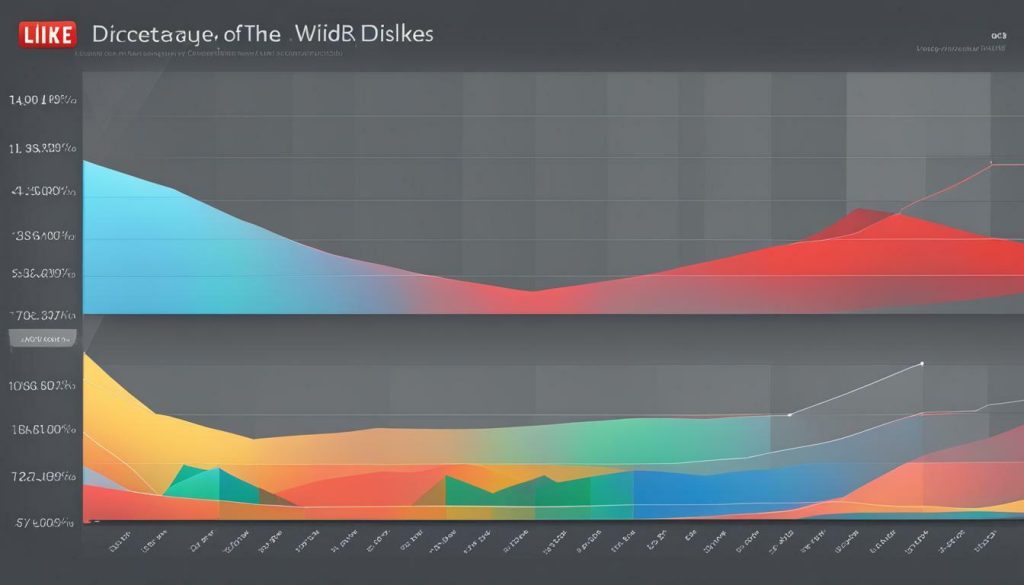
YouTube has disabled the public display of dislike counts, but there are still ways to see how many dislikes a video has received. If you’re curious about the dislike count on YouTube and want to learn how to see dislikes, this simple guide will show you how.
One way to restore the visibility of dislikes on YouTube is by using a browser extension called “Return YouTube Dislike.” This extension can be installed on popular browsers like Firefox, Chrome, Microsoft Edge, Opera, and Brave. It allows you to view the like-to-dislike ratio on YouTube videos once again.
However, it’s important to note that the dislike counts provided by the browser extension may not be entirely accurate. The extension uses a combination of cached data and extrapolated user behavior to estimate the dislikes on a video. While the numbers may not be exact, they should provide a general idea of the ratio between likes and dislikes.
YouTube disabled the like-to-dislike ratio in response to targeted attacks and mass dislike campaigns on creators’ content. While this decision was made to protect creators from harassment, it also removed one of the few metrics available for gauging the quality of a video on the platform.
Key Takeaways:
- Use the browser extension “Return YouTube Dislike” to restore the visibility of dislikes on YouTube.
- The dislike counts provided by the extension are estimated based on cached data and extrapolated user behavior.
- YouTube disabled the like-to-dislike ratio to address targeted attacks and mass dislike campaigns on creators’ content.
Now that you know how to see dislikes on YouTube, you can make more informed decisions when watching videos and engage with the platform in a more meaningful way.
Restoring Dislikes with a Browser Extension
By installing a browser extension called “Return YouTube Dislike,” users can once again see the dislikes on YouTube videos. This extension is available for popular browsers such as Chrome, Firefox, Microsoft Edge, Opera, and Brave. It provides a simple solution to restore the visibility of dislikes, giving users valuable information about the like-to-dislike ratio.
The process of installing the extension is straightforward. For Chrome users, they can find it in the Chrome Web Store and add it to their browser. Firefox users can visit the Mozilla Add-Ons repository to download the extension. Once installed, users can head to a YouTube video and see the dislike count alongside the like counter. The extension retrieves cached data from before YouTube disabled the dislike function and combines it with user behavior to estimate the current number of dislikes.
The accuracy of the dislike count provided by the browser extension may not be 100% accurate, but it offers a close approximation of the ratio. The extension relies on user-contributed data to determine the ratio, which means that the extension author collects information about the videos users watch. Tech YouTube channel LinusTechTips compared the extension’s counts with their own and found them to be mostly accurate, providing users with a valuable tool to assess the quality and trustworthiness of videos on YouTube.

The Accuracy of Dislike Counts
The browser extension works by combining cached data from YouTube’s API and extrapolating user behavior, resulting in an estimated dislike count that may not be entirely accurate. The extension, such as “Return YouTube Dislike,” collects data from users who have the extension installed on their browsers to determine the like-to-dislike ratio for each video.
By utilizing the cached data obtained before YouTube disabled access to the dislike function in its API, the extension provides a reasonable estimate of the number of dislikes on a given video. However, it’s important to note that the actual number of dislikes may not be precisely reflected due to the reliance on extrapolated user behavior.
The accuracy of the extension’s data depends on the number of people using it and contributing their data. A comparison conducted by LinusTechTips, a popular tech YouTube channel, found that the dislike counts provided by the extension were mostly accurate. While it may not be perfect, this method can still be helpful in identifying potential scams or inaccurate information.
The Accuracy of Dislike Counts
“The extension works using a combination of cached data that was grabbed before YouTube disabled access to the dislike function in its API, and extrapolated user behavior. This means that the number of dislikes on any given video will not be correct, but the ratio should be somewhat accurate.”
| Pros | Cons |
|---|---|
| – Provides an estimated dislike count | – The number of dislikes may not be entirely accurate |
| – Helps avoid scams or inaccurate content | – Relies on extrapolated user behavior |
| – Offers insight into the like-to-dislike ratio | – Accuracy depends on the number of users contributing data |
“YouTube disabled like-to-dislike ratios in response to brigading and mass dislike campaigns leveled at some creators not for the quality of the content but due to targeted attacks. While this is a valid concern, the move also knocked out one of the only metrics for gauging a video’s worth on the platform.”
YouTube’s decision to remove the like-to-dislike ratio was aimed at addressing targeted harassment and negativity towards creators by eliminating the ability for users to engage in mass dislike campaigns. However, it also resulted in the loss of a valuable metric for assessing the quality and credibility of videos on the platform.
YouTube suggests that viewers rely on comments to gauge video quality, but this can be challenging due to the prevalence of spam and hate comments. YouTube’s reliance on users reporting comments may also prove to be an imperfect solution.
Overall, while the browser extension provides a workaround for seeing the like-to-dislike ratio on YouTube, it’s important to be aware of its limitations and that the dislike count may not be entirely accurate. It remains crucial for viewers to use their judgment, consider other factors such as comments and engagement, and rely on reliable sources to assess the quality of videos on YouTube.

Gauging Video Quality on YouTube
YouTube disabled the like-to-dislike ratios to address targeted attacks and mass dislike campaigns, but it removed a valuable metric for gauging video quality. The like-to-dislike ratio provided viewers with a quick and easy way to assess whether a video was well-received or had a negative reception. However, without the dislike count, viewers are left without a clear indicator of a video’s quality.
While YouTube suggests that viewers resort to reading comments to gauge video quality, this is not always a reliable measure. Many creators disable comments to avoid spam and hate, making it difficult for viewers to get meaningful feedback from other users.
“YouTube disabled the like-to-dislike ratios to address targeted attacks and mass dislike campaigns, but it removed a valuable metric for gauging video quality.”
However, there are alternative ways for viewers to assess video quality on YouTube. One method is to rely on the reputation and credibility of the content creator. Established creators who consistently produce high-quality content are more likely to have positive engagement, such as likes and positive comments. Additionally, looking at the view count of a video can provide some insight into its popularity and potential quality.
“One method is to rely on the reputation and credibility of the content creator.”
Another strategy is to look for external sources of information or reviews. Many websites and social media platforms provide reviews and recommendations for YouTube videos and channels. Reading reviews from trusted sources can give you an idea of the video’s quality before watching it.
“Another strategy is to look for external sources of information or reviews.”
| Pros | Cons |
|---|---|
| Assess video quality based on creator reputation | Lack of a standardized metric for video quality |
| Consider view count as an indicator of popularity | Limited feedback from comments due to disabled comments or spam |
| Seek external reviews and recommendations | Reliance on subjective opinions |
Gauging Video Quality: A Summary
Gauging video quality on YouTube has become more challenging since the removal of the like-to-dislike ratios. While YouTube suggested relying on comments, this method may not always be reliable due to disabled comments or spam. Instead, viewers can consider the reputation and credibility of the content creator, the view count of the video, and seek external reviews and recommendations. Although no standardized metric for video quality currently exists, these strategies can provide some insight into whether a video is worth watching.

How Creators Can See Dislikes
Content creators can view the exact number of dislikes their videos have received by accessing YouTube Studio and checking the analytics section. This provides valuable insights into audience engagement and feedback. By knowing the number of dislikes, creators can better understand the reception of their content and make informed decisions moving forward.
Accessing the dislike count is a simple process:
- Log in to your YouTube account and go to YouTube Studio.
- Click on the “Analytics” tab in the left-hand menu.
- In the “Top Videos” section, click on the title of the video you want to see the dislikes for.
- Scroll down to the “Engagement” section, where you will find the likes and dislikes your video has received.
This information allows creators to gauge the overall reception of their videos and make adjustments to improve their content or address any specific concerns raised by viewers.

Why Dislike Counts Matter for Creators
Dislike counts provide creators with valuable feedback and insights into their content. While it’s natural to want everyone to like your videos, receiving dislikes can actually be beneficial. Dislikes can generate engagement and feedback, which can help creators refine their content and create more appealing videos.
However, it’s important to remember that dislikes alone do not determine the quality or value of a video. Creators should consider dislikes in the context of overall audience engagement, including likes, comments, and view counts. By analyzing these metrics in YouTube Studio, creators can gain a comprehensive understanding of how their videos are received and make data-driven decisions to improve their content strategy.
| Frequently Asked Questions: |
|---|
|
Can creators still view their own dislike stats? Yes, YouTube Studio provides creators with access to precise dislike counts for their videos. This feature allows creators to stay informed about audience feedback and make adjustments to their content strategy. |
|
Why are dislike counts important for creators? Dislike counts offer valuable insights into audience engagement and provide feedback for creators. By understanding dislikes, creators can make informed decisions to improve their content and better cater to their audience’s preferences. |
|
How can creators use dislike counts effectively? Dislike counts should be considered in conjunction with other engagement metrics like likes, comments, and view counts. Analyzing these metrics collectively provides a more comprehensive understanding of audience reception and enables creators to refine their content strategy accordingly. |
In conclusion, being able to access dislike counts is essential for content creators to understand audience feedback and improve their videos. By utilizing YouTube Studio analytics, creators can gain valuable insights and make data-driven decisions to enhance their content and engage their audience more effectively.
Conclusion
Despite YouTube’s decision to remove public dislike counts, users can still restore this feature with the help of a browser extension, allowing them to make more informed decisions when viewing videos on the platform. The browser extension “Return YouTube Dislike” can be installed on popular browsers like Chrome, Edge, Firefox, and even Safari with the help of a userscript. This extension utilizes cached data and user behavior to provide an estimated dislike count and ratio for YouTube videos.
While the accuracy of the extension’s data may vary, tests have shown that it is mostly reliable. Users contribute their data to help determine the ratio, which helps improve the accuracy over time. However, it’s important to note that only content creators can access the exact number of dislikes on their videos through YouTube Studio.
The removal of dislike counts by YouTube was a response to targeted attacks and mass dislike campaigns. However, this move has also made it challenging for viewers to gauge the quality of videos. YouTube now recommends relying on comments for feedback, but this can be unreliable due to spam and hateful comments. By restoring the visibility of dislikes through the browser extension, viewers have an additional metric to evaluate a video’s worth and credibility.
In conclusion, the ability to see dislikes on YouTube can provide valuable information to viewers and creators alike. The “Return YouTube Dislike” browser extension offers a solution for users who want to restore this feature and make more informed decisions when watching videos on the platform. While it may not provide the exact number of dislikes, it offers a glimpse into the like-to-dislike ratio, allowing users to better assess the quality and credibility of videos on YouTube.
FAQ
Q: Can I still see the number of dislikes on a YouTube video?
A: No, YouTube removed the public display of exact dislike counts on videos. The ratio of likes to dislikes is still visible, but the specific number of dislikes is only visible to the video owner and creators of the channel.
Q: Why did YouTube remove the dislike count?
A: YouTube removed the dislike count to discourage targeted harassment and negativity towards certain content or creators.
Q: Can the creator of the video still see the number of dislikes?
A: Yes, video creators can still see the exact number of dislikes on their videos. The removal of public dislike counts only affects viewers who are not the video owner or part of the creator’s channel.
Q: What is the reason behind YouTube’s decision to remove the dislike count?
A: YouTube decided to remove the public display of the exact number of dislikes to reduce targeted harassment and negativity towards certain content or creators. By removing the dislike count, YouTube aims to discourage users from engaging in coordinated campaigns to dislike videos and damage a video’s reputation.






